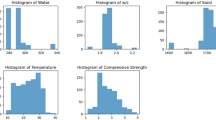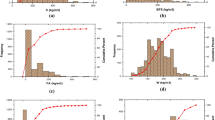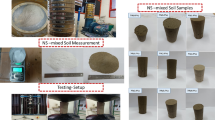Abstract
Recycled aggregate concrete is used as an alternative material in construction engineering, aiming to environmental protection and sustainable development. However, the compressive strength of this concrete material is considered as a crucial parameter and an important concern for construction engineers regarding its application. In the present work, the 28-days compressive strength of recycled aggregate concrete is investigated through four artificial intelligence techniques based on a meta-heuristic search of sociopolitical algorithm (i.e. ICA) and XGBoost, called the ICA-XGBoost model. Based on performance indices, the optimum among these developed models proved to be ICA-XGBoost model. Namely, findings demonstrated that the proposed ICA-XGBoost model performed better than the other models (i.e. ICA-ANN, ICA-SVR, and ICA-ANFIS models) in estimating compressive strength of recycled aggregate concrete. The suggested model can be used in construction engineering in order to ensure adequate mechanical performance of the recycled aggregate concrete and allow its safe use for building purposes.



















Similar content being viewed by others
References
Asteris PG, Mokos VG (2019) Concrete compressive strength using artificial neural networks. Neural Comput Appl. https://doi.org/10.1007/s00521-019-04663-2
Apostolopoulou M, Douvika MG, Kanellopoulos IN, Moropoulou A, Asteris PG (2018) Prediction of compressive strength of mortars using artificial neural networks. In: Proceedings of the 1st international conference TMM_CH, transdisciplinary multispectral modelling and cooperation for the preservation of cultural heritage, Athens, Greece, 10–13
Silva R, De Brito J, Dhir R (2015) The influence of the use of recycled aggregates on the compressive strength of concrete: a review. Eur J Environ Civ Eng 19(7):825–849
Tu T-Y, Chen Y-Y, Hwang C-L (2006) Properties of HPC with recycled aggregates. Cem Concr Res 36(5):943–950
Shang Y, Nguyen H, Bui X-N, Tran Q-H, Moayedi H (2019) A novel artificial intelligence approach to predict blast-induced ground vibration in open-pit mines based on the firefly algorithm and artificial neural network. Nat Resour Res. https://doi.org/10.1007/s11053-019-09503-7
Nguyen H, Moayedi H, Foong LK, Al Najjar HAH, Jusoh WAW, Rashid ASA, Jamali J (2019) Optimizing ANN models with PSO for predicting short building seismic response. Eng Comput. https://doi.org/10.1007/s00366-019-00733-0
Nguyen H, Drebenstedt C, Bui X-N, Bui DT (2019) Prediction of blast-induced ground vibration in an open-pit mine by a novel hybrid model based on clustering and artificial neural network. Nat Resour Res. https://doi.org/10.1007/s11053-019-09470-z
Zhang X, Nguyen H, Bui X-N, Tran Q-H, Nguyen D-A, Bui DT, Moayedi H (2019) Novel soft computing model for predicting blast-induced ground vibration in open-pit mines based on particle swarm optimization and XGBoost. Nat Resour Res. https://doi.org/10.1007/s11053-019-09492-7
Zhou J, Li X, Mitri HS (2018) Evaluation method of rockburst: state-of-the-art literature review. Tunn Undergr Sp Technol 81:632–659
Zhou J, Li E, Yang S, Wang M, Shi X, Yao S, Mitri HS (2019) Slope stability prediction for circular mode failure using gradient boosting machine approach based on an updated database of case histories. Saf Sci 118:505–518
Zhang S, Bui X-N, Trung N-T, Nguyen H, Bui H-B (2019) Prediction of rock size distribution in mine bench blasting using a novel ant colony optimization-based boosted regression tree technique. Nat Resour Res. https://doi.org/10.1007/s11053-019-09603-4
Zhang H, Nguyen H, Bui X-N, Nguyen-Thoi T, Bui T-T, Nguyen N, Vu D-A, Mahesh V, Moayedi H (2020) Developing a novel artificial intelligence model to estimate the capital cost of mining projects using deep neural network-based ant colony optimization algorithm. Resour Policy 66:101604
Rao A, Jha KN, Misra S (2007) Use of aggregates from recycled construction and demolition waste in concrete. Resour Conserv Recycl 50(1):71–81
Asteris PG, Moropoulou A, Skentou AD, Apostolopoulou M, Mohebkhah A, Cavaleri L, Rodrigues H, Varum H (2019) Stochastic vulnerability assessment of masonry structures: concepts, modeling and restoration aspects. Appl Sci 9(2):243
Asteris PG, Apostolopoulou M, Skentou AD, Moropoulou A (2019) Application of artificial neural networks for the prediction of the compressive strength of cement-based mortars. Comput Concr 24(4):329–345
Limbachiya M, Leelawat T, Dhir R (2000) Use of recycled concrete aggregate in high-strength concrete. Mater Struct 33(9):574
Poon C-S, Chan D (2007) The use of recycled aggregate in concrete in Hong Kong. Resour Conserv Recycl 50(3):293–305
Poon C, Kou S, Lam L (2002) Use of recycled aggregates in molded concrete bricks and blocks. Constr Build Mater 16(5):281–289
Oikonomou ND (2005) Recycled concrete aggregates. Cem Concr Compos 27(2):315–318
Shi X, Wang Q, Zhao X, Collins F (2011) Strength and ductility of recycled aggregate concrete filled composite tubular stub columns. In: Incorporating sustainable practice in mechanics of structures and materials, London, UK, pp 83–89
Wang Y, Chen J, Geng Y (2015) Testing and analysis of axially loaded normal-strength recycled aggregate concrete filled steel tubular stub columns. Eng Struct 86:192–212
Tam VW, Soomro M, Evangelista ACJ (2018) A review of recycled aggregate in concrete applications (2000–2017). Constr Build Mater 172:272–292
Asteris PG, Ashrafian A, Rezaie-Balf M (2019) Prediction of the compressive strength of self-compacting concrete using surrogate models. Comput Concr 24:137–150
Zhou J, Li X, Mitri HS (2016) Classification of rockburst in underground projects: comparison of ten supervised learning methods. J Comput Civ Eng 30(5):04016003
Zhou J, Li X, Shi X (2012) Long-term prediction model of rockburst in underground openings using heuristic algorithms and support vector machines. Saf Sci 50(4):629–644
Liu T, Zhang C, Cao P, Zhou K (2020) Freeze-thaw damage evolution of fractured rock mass using nuclear magnetic resonance technology. Cold Reg Sci Technol 170:102951
Duan Z-H, Kou S-C, Poon C-S (2013) Prediction of compressive strength of recycled aggregate concrete using artificial neural networks. Constr Build Mater 40:1200–1206
Younis KH, Pilakoutas K (2013) Strength prediction model and methods for improving recycled aggregate concrete. Constr Build Mater 49:688–701
Deshpande N, Londhe S, Kulkarni S (2014) Modeling compressive strength of recycled aggregate concrete by artificial neural network, model tree and non-linear regression. Int J Sustain Built Environ 3(2):187–198
Khademi F, Jamal SM, Deshpande N, Londhe S (2016) Predicting strength of recycled aggregate concrete using artificial neural network, adaptive neuro-fuzzy inference system and multiple linear regression. Int J Sustain Built Environ 5(2):355–369
Khosravi K, Mao L, Kisi O, Yaseen ZM, Shahid S (2018) Quantifying hourly suspended sediment load using data mining models: case study of a glacierized Andean catchment in Chile. J Hydrol 567:165–179
Khosravi K, Panahi M, Bui DT (2018) Spatial prediction of groundwater spring potential mapping based on an adaptive neuro-fuzzy inference system and metaheuristic optimization. Hydrol Earth Syst Sci 22(9):4771–4792. https://doi.org/10.5194/hess-22-4771-2018
Zhang J-P, Li Z-W, Yang J (2005) A parallel SVM training algorithm on large-scale classification problems. In: 2005 International conference on machine learning and cybernetics, IEEE, pp 1637–1641
Zhang R, Ma J (2008) An improved SVM method P-SVM for classification of remotely sensed data. Int J Remote Sens 29(20):6029–6036
Huang G-B, Wang DH, Lan Y (2011) Extreme learning machines: a survey. Int J Mach Learn Cybern 2(2):107–122
Abdollahzadeh G, Jahani E, Kashir Z (2016) Predicting of compressive strength of recycled aggregate concrete by genetic programming. Comput Concr 18(2):155–163
Deng F, He Y, Zhou S, Yu Y, Cheng H, Wu X (2018) Compressive strength prediction of recycled concrete based on deep learning. Constr Build Mater 175:562–569
Dantas ATA, Leite MB, de Jesus Nagahama K (2013) Prediction of compressive strength of concrete containing construction and demolition waste using artificial neural networks. Constr Build Mater 38:717–722
Omran BA, Chen Q, Jin R (2016) Comparison of data mining techniques for predicting compressive strength of environmentally friendly concrete. J Comput Civ Eng 30(6):04016029
Khademi F, Jamal SM (2016) Predicting the 28 days compressive strength of concrete using artificial neural network. I-manager’s J Civ Eng 6(2):1–6. https://doi.org/10.26634/jce.6.2.5936
Naderpour H, Rafiean AH, Fakharian P (2018) Compressive strength prediction of environmentally friendly concrete using artificial neural networks. J Build Eng 16:213–219
Asteris PG, Nikoo M (2019) Artificial bee colony-based neural network for the prediction of the fundamental period of infilled frame structures. Neural Comput Appl 31(9):4837–4847. https://doi.org/10.1007/s00521-018-03965-1
Asteris PG, Kolovos KG (2019) Self-compacting concrete strength prediction using surrogate models. Neural Comput Appl 31(1):409–424
Asteris PG, Nozhati S, Nikoo M, Cavaleri L, Nikoo M (2019) Krill herd algorithm-based neural network in structural seismic reliability evaluation. Mech Adv Mater Struct 26(13):1146–1153
Asteris P, Roussis P, Douvika M (2017) Feed-forward neural network prediction of the mechanical properties of sandcrete materials. Sensors 17(6):1344
Sarir P, Chen J, Asteris PG, Armaghani DJ, Tahir MM (2019) Developing GEP tree-based, neuro-swarm, and whale optimization models for evaluation of bearing capacity of concrete-filled steel tube columns. Eng Comput. https://doi.org/10.1007/s00366-019-00808-y
Liu T, Zhang C, Zhou K, Tian Y (2019) Freeze-thaw cycling damage evolution of additive cement mortar. Eur J Environ Civ Eng. https://doi.org/10.1080/19648189.2019.1615992
Ni H-G, Wang J-Z (2000) Prediction of compressive strength of concrete by neural networks. Cem Concr Res 30(8):1245–1250
Topcu IB, Sarıdemir M (2008) Prediction of compressive strength of concrete containing fly ash using artificial neural networks and fuzzy logic. Comput Mater Sci 41(3):305–311
Kewalramani MA, Gupta R (2006) Concrete compressive strength prediction using ultrasonic pulse velocity through artificial neural networks. Autom Constr 15(3):374–379
Alshihri MM, Azmy AM, El-Bisy MS (2009) Neural networks for predicting compressive strength of structural light weight concrete. Constr Build Mater 23(6):2214–2219
Sobhani J, Najimi M, Pourkhorshidi AR, Parhizkar T (2010) Prediction of the compressive strength of no-slump concrete: a comparative study of regression, neural network and ANFIS models. Constr Build Mater 24(5):709–718
Khademi F, Akbari M, Jamal SM, Nikoo M (2017) Multiple linear regression, artificial neural network, and fuzzy logic prediction of 28 days compressive strength of concrete. Front Struct Civ Eng 11(1):90–99
Yaseen ZM, Deo RC, Hilal A, Abd AM, Bueno LC, Salcedo-Sanz S, Nehdi ML (2018) Predicting compressive strength of lightweight foamed concrete using extreme learning machine model. Adv Eng Softw 115:112–125
Chopra P, Sharma RK, Kumar M (2016) Prediction of compressive strength of concrete using artificial neural network and genetic programming. Adv Mater Sci Eng 2016:1–10. https://doi.org/10.1155/2016/7648467
Nikoo M, Torabian Moghadam F, Sadowski Ł (2015) Prediction of concrete compressive strength by evolutionary artificial neural networks. Adv Mater Sci Eng 2015:1–8. https://doi.org/10.1155/2015/849126
Ling H, Qian C, Kang W, Liang C, Chen H (2019) Combination of support vector machine and k-fold cross validation to predict compressive strength of concrete in marine environment. Constr Build Mater 206:355–363
Behnood A, Golafshani EM (2018) Predicting the compressive strength of silica fume concrete using hybrid artificial neural network with multi-objective grey wolves. J Clean Prod 202:54–64
Behnood A, Olek J, Glinicki MA (2015) Predicting modulus elasticity of recycled aggregate concrete using M5′ model tree algorithm. Constr Build Mater 94:137–147
Atashpaz-Gargari E, Lucas C (2007) Imperialist competitive algorithm: an algorithm for optimization inspired by imperialistic competition. In: 2007 IEEE congress on evolutionary computation. IEEE, pp 4661–4667
Hosseini S, Al Khaled A (2014) A survey on the imperialist competitive algorithm metaheuristic: implementation in engineering domain and directions for future research. Appl Soft Comput 24:1078–1094
Elsisi M (2019) Design of neural network predictive controller based on imperialist competitive algorithm for automatic voltage regulator. Neural Comput Appl 31(9):5017–5027. https://doi.org/10.1007/s00521-018-03995-9
Shirazi AZ, Mohammadi Z (2017) A hybrid intelligent model combining ANN and imperialist competitive algorithm for prediction of corrosion rate in 3C steel under seawater environment. Neural Comput Appl 28(11):3455–3464
Le LT, Nguyen H, Dou J, Zhou J (2019) A comparative study of PSO-ANN, GA-ANN, ICA-ANN, and ABC-ANN in estimating the heating load of buildings’ energy efficiency for smart city planning. Appl Sci 9(13):2630
Chen T, He T (2015) Xgboost: extreme gradient boosting. R package version 04-2
Friedman JH (2002) Stochastic gradient boosting. Comput Stat Data Anal 38(4):367–378
Zhou J, Li E, Wang M, Chen X, Shi X, Jiang L (2019) Feasibility of stochastic gradient boosting approach for evaluating seismic liquefaction potential based on SPT and CPT case histories. J Perform Constr Facil 33(3):04019024
Cortes C, Vapnik V (1995) Support-vector networks. Mach Learn 20(3):273–297
Basak D, Pal S, Patranabis DC (2007) Support vector regression. Neural Inf Process-Lett Rev 11(10):203–224
Nguyen H (2019) Support vector regression approach with different kernel functions for predicting blast-induced ground vibration: a case study in an open-pit coal mine of Vietnam. SN Appl Sci 1(4):283. https://doi.org/10.1007/s42452-019-0295-9
Bui X-N, Nguyen H, Le HA, Bui HB, Do NH (2019) Prediction of blast-induced air over-pressure in open-pit mine: assessment of different artificial intelligence techniques. Nat Resour Res. https://doi.org/10.1007/s11053-019-09461-0
Liu L, Moayedi H, Rashid ASA, Rahman SSA, Nguyen H (2019) Optimizing an ANN model with genetic algorithm (GA) predicting load-settlement behaviours of eco-friendly raft-pile foundation (ERP) system. Eng Comput 36(1):421–433. https://doi.org/10.1007/s00366-019-00767-4
Wang B, Moayedi H, Nguyen H, Foong LK, Rashid ASA (2019) Feasibility of a novel predictive technique based on artificial neural network optimized with particle swarm optimization estimating pullout bearing capacity of helical piles. Eng Comput. https://doi.org/10.1007/s00366-019-00764-7
Bui X, Muazu MA, Nguyen H (2019) Optimizing Levenberg–Marquardt backpropagation technique in predicting factor of safety of slopes after two-dimensional OptumG2 analysis. Eng Comput. https://doi.org/10.1007/s00366-019-00741-0
Nguyen H, Moayedi H, Foong LK, Al Najjar HAH, Jusoh WAW, Rashid ASA, Jamali J (2019) Optimizing ANN models with PSO for predicting short building seismic response. Eng Comput. https://doi.org/10.1007/s00366-019-00733-0
Moayedi H, Moatamediyan A, Nguyen H, Bui X-N, Bui DT, Rashid ASA (2019) Prediction of ultimate bearing capacity through various novel evolutionary and neural network models. Eng Comput. https://doi.org/10.1007/s00366-019-00723-2
Yegnanarayana B (2009) Artificial neural networks. PHI Learning Pvt. Ltd, New Delhi
Buscema PM, Massini G, Breda M, Lodwick WA, Newman F, Asadi-Zeydabadi M (2018) Artificial adaptive systems using auto contractive maps: theory, applications and extensions, vol 131. Springer, Berlin
Gao W, Guirao JLG, Abdel-Aty M, Xi W (2018) An independent set degree condition for fractional critical deleted graphs. Discrete Contin Dyn Syst-S 12(4&5):877–886. https://doi.org/10.3934/dcdss.2019058
Asteris PG, Armaghani DJ, Hatzigeorgiou GD, Karayannis CG, Pilakoutas K (2019) Predicting the shear strength of reinforced concrete beams using artificial neural networks. Comput Concr 24(5):469–488
Bui DT, Tuan TA, Klempe H, Pradhan B, Revhaug I (2016) Spatial prediction models for shallow landslide hazards: a comparative assessment of the efficacy of support vector machines, artificial neural networks, kernel logistic regression, and logistic model tree. Landslides 13(2):361–378
Nguyen H, Bui X-N, Bui H-B, Mai N-L (2018) A comparative study of artificial neural networks in predicting blast-induced air-blast overpressure at Deo Nai open-pit coal mine, Vietnam. Neural Comput Appl. https://doi.org/10.1007/s00521-018-3717-5
Apostolopoulou M, Armaghani DJ, Bakolas A, Douvika MG, Moropoulou A, Asteris PG (2019) Compressive strength of natural hydraulic lime mortars using soft computing techniques. Proc Struct Integr 17:914–923
Choubin B, Khalighi-Sigaroodi S, Malekian A, Kişi Ö (2016) Multiple linear regression, multi-layer perceptron network and adaptive neuro-fuzzy inference system for forecasting precipitation based on large-scale climate signals. Hydrol Sci J 61(6):1001–1009
Jang J-S (1993) ANFIS: adaptive-network-based fuzzy inference system. IEEE Trans Syst Man Cybern 23(3):665–685
Chang F-J, Chang Y-T (2006) Adaptive neuro-fuzzy inference system for prediction of water level in reservoir. Adv Water Resour 29(1):1–10
Manogaran G, Varatharajan R, Priyan M (2018) Hybrid recommendation system for heart disease diagnosis based on multiple kernel learning with adaptive neuro-fuzzy inference system. Multimed Tools Appl 77(4):4379–4399
Hong H, Panahi M, Shirzadi A, Ma T, Liu J, Zhu A-X, Chen W, Kougias I, Kazakis N (2018) Flood susceptibility assessment in Hengfeng area coupling adaptive neuro-fuzzy inference system with genetic algorithm and differential evolution. Sci Total Environ 621:1124–1141
Aghdam IN, Varzandeh MHM, Pradhan B (2016) Landslide susceptibility mapping using an ensemble statistical index (Wi) and adaptive neuro-fuzzy inference system (ANFIS) model at Alborz Mountains (Iran). Environ Earth Sci 75(7):553
Chen W, Panahi M, Pourghasemi HR (2017) Performance evaluation of GIS-based new ensemble data mining techniques of adaptive neuro-fuzzy inference system (ANFIS) with genetic algorithm (GA), differential evolution (DE), and particle swarm optimization (PSO) for landslide spatial modelling. CATENA 157:310–324
Shabri A (2014) A hybrid wavelet analysis and adaptive neuro-fuzzy inference system for drought forecasting. Appl Math Sci 8(139):6909–6918
Psyllaki P, Stamatiou K, Iliadis I, Mourlas A, Asteris P, Vaxevanidis N (2018) Surface treatment of tool steels against galling failure. In: MATEC web of conferences. EDP Sciences, p 04024
Cavaleri L, Chatzarakis GE, Trapani FD, Douvika MG, Roinos K, Vaxevanidis NM, Asteris PG (2017) Modeling of surface roughness in electro-discharge machining using artificial neural networks. Adv Mater Res 6(2):169–184
Cavaleri L, Asteris PG, Psyllaki PP, Douvika MG, Skentou AD, Vaxevanidis NM (2019) Prediction of surface treatment effects on the tribological performance of tool steels using artificial neural networks. Appl Sci 9(14):2788
Armaghani DJ, Hatzigeorgiou GD, Karamani C, Skentou A, Zoumpoulaki I, Asteris PG (2019) Soft computing-based techniques for concrete beams shear strength. Proc Struct Integr 17:924–933
Khosravi K, Shahabi H, Pham BT, Adamowski J, Shirzadi A, Pradhan B, Dou J, Ly H-B, Gróf G, Ho HL (2019) A comparative assessment of flood susceptibility modeling using multi-criteria decision-making analysis and machine learning methods. J Hydrol 573:311–323
Khozani ZS, Khosravi K, Pham BT, Kløve B, Mohtar W, Melini WH, Yaseen ZM (2019) Determination of compound channel apparent shear stress: application of novel data mining models. J Hydroinform 21(5):798–811. https://doi.org/10.2166/hydro.2019.037
Dhaliwal S, Nahid A-A, Abbas R (2018) Effective intrusion detection system using XGBoost. Information 9(7):149
Nguyen H, Bui X-N, Bui H-B, Cuong DT (2019) Developing an XGBoost model to predict blast-induced peak particle velocity in an open-pit mine: a case study. Acta Geophys 67(2):477–490. https://doi.org/10.1007/s11600-019-00268-4
Acknowledgments
This research was supported by Hanoi University of Mining and Geology (HUMG), Hanoi, Vietnam and the Center for Mining, Electro-Mechanical Research of HUMG.
Author information
Authors and Affiliations
Corresponding author
Ethics declarations
Conflict of interest
The authors declare no conflict of interest.
Additional information
Publisher's Note
Springer Nature remains neutral with regard to jurisdictional claims in published maps and institutional affiliations.
Rights and permissions
About this article
Cite this article
Duan, J., Asteris, P.G., Nguyen, H. et al. A novel artificial intelligence technique to predict compressive strength of recycled aggregate concrete using ICA-XGBoost model. Engineering with Computers 37, 3329–3346 (2021). https://doi.org/10.1007/s00366-020-01003-0
Received:
Accepted:
Published:
Issue Date:
DOI: https://doi.org/10.1007/s00366-020-01003-0




